

This Graphene-Based Paper Can Walk, Fold and Twirl on Its Own. Scientists develop 'unbreakable' glass almost as tough as steel. Japanese researchers have developed a new type of glass almost as hard as steel, a breakthrough that could lead to the development of substantially tougher windows and tableware.
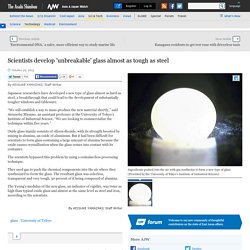
“We will establish a way to mass-produce the new material shortly,” said Atsunobu Masuno, an assistant professor at the University of Tokyo’s Institute of Industrial Science. Harvard John A. Paulson School of Engineering and Applied Sciences. Electrons are so 20th century.
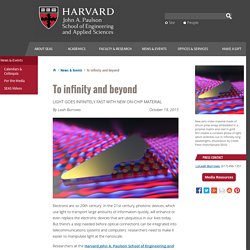
In the 21st century, photonic devices, which use light to transport large amounts of information quickly, will enhance or even replace the electronic devices that are ubiquitous in our lives today. But there’s a step needed before optical connections can be integrated into telecommunications systems and computers: researchers need to make it easier to manipulate light at the nanoscale. Researchers at the Harvard John A. This Gemstone Is Two Different Colors At Once.
Another Report Laments the Status of Carbon Nanotube Development. In the last half-a-decade we have witnessed once-beloved carbon nanotubes (CNTs) slowly being eclipsed by graphene as the “wonder material” of the nanomaterial universe.

This changing of the guard has occurred primarily within the research community, where the amount of papers being published about graphene seems to be steadily increasing. But in terms of commercial development, CNTs still have a leg up on graphene, finding increasing use in creating light but strong composites. Nonetheless, the commercial prospects for CNTs have been taking hits recently, with some producers scaling down capacity because of lack of demand.
With this as the backdrop, the National Nanotechnology Initiative (NNI), famous for its estimate back in 2001 that the market for nanotechnology will be worth $1 trillion by 2015, has released a report based on a meeting held last September. Graphene: Fast, Strong, Cheap, and Impossible to Use - The New Yorker. Until Andre Geim, a physics professor at the University of Manchester, discovered an unusual new material called graphene, he was best known for an experiment in which he used electromagnets to levitate a frog.
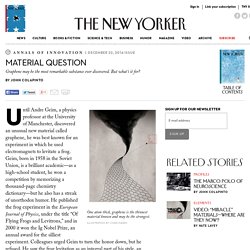
Geim, born in 1958 in the Soviet Union, is a brilliant academic—as a high-school student, he won a competition by memorizing a thousand-page chemistry dictionary—but he also has a streak of unorthodox humor. He published the frog experiment in the European Journal of Physics, under the title “Of Flying Frogs and Levitrons,” and in 2000 it won the Ig Nobel Prize, an annual award for the silliest experiment. Colleagues urged Geim to turn the honor down, but he refused. We've Just Developed a Portable Cloaking Device How Nanoscale Optics Create Nature's Most Dazzling Colors. Sea Snail Teeth Are The Strongest Known Biological Structures. Novel non-stick material joins portfolio of slippery surface technologies. Harvard researchers have demonstrated a powerful, long-lasting repellent surface technology that can be used with medical materials to prevent infections caused by biofilms.
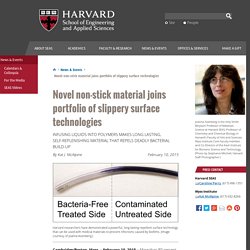
(Image courtesy of Joanna Aizenberg.) Cambridge/Boston, Mass. – February 10, 2015 – More than 80 percent of microbial infections in the human body are caused by a build-up of bacteria, according to the National Institutes of Health. Bacteria cells gain a foothold in the body by accumulating and forming into adhesive colonies called biofilms, which help them to thrive and survive but cause infections and associated life-threatening risks to their human hosts. These biofilms commonly form on medical surfaces including those of mechanical heart valves, urinary catheters, intravenous catheters, and implants.
Materials. Super Strong Materials. Super Coatings. Super Materials. New amazing metal is so hydrophobic it makes water bounce like magic. Smallest Possible Diamonds Form Ultra-thin Nanothreads. John Badding, professor of chemistry at Penn State University, leads a research team that has discovered how to produce super-strong, super-thin "diamond nanothreads" that promise extraordinary properties such as strength and stiffness higher than that of carbon nanotubes or conventional high-strength polymers.
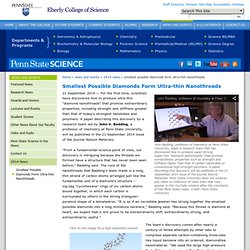
A paper describing this discovery will be published in the 21 September 2014 issue of the journal Nature Materials. Penn State University does not endorse any video or collection of video links that may appear in this YouTube window after the conclusion of this Penn State video. Credit: Penn State University. Professors' super waterproof surfaces cause water to bounce like a ball. In a basement lab on BYU’s campus, mechanical engineering professor Julie Crockett analyzes water as it bounces like a ball and rolls down a ramp.
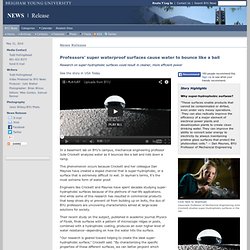
This phenomenon occurs because Crockett and her colleague Dan Maynes have created a sloped channel that is super-hydrophobic, or a surface that is extremely difficult to wet. In layman’s terms, it’s the most extreme form of water proof. Engineers like Crockett and Maynes have spent decades studying super-hydrophobic surfaces because of the plethora of real-life applications. Icists show unlimited heat conduction in graphene. Scientists at the Max Planck Institute for Polymer Research (MPI-P) in Mainz and the National University of Singapore have attested that the thermal conductivity of graphene diverges with the size of the samples.
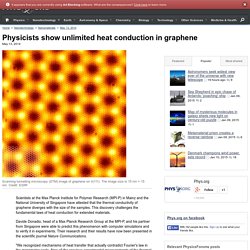
This discovery challenges the fundamental laws of heat conduction for extended materials. Scientists just created some of the most powerful muscles in existence. PodShark comments on New bone-like material is lighter than water but as strong as steel. New bone-like material is lighter than water but as strong as steel. Materials shape human progress – think stone age or bronze age.
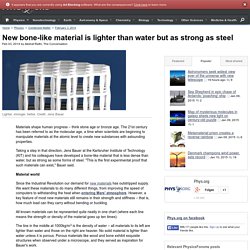
The 21st century has been referred to as the molecular age, a time when scientists are beginning to manipulate materials at the atomic level to create new substances with astounding properties. Taking a step in that direction, Jens Bauer at the Karlsruher Institute of Technology (KIT) and his colleagues have developed a bone-like material that is less dense than water, but as strong as some forms of steel. "This is the first experimental proof that such materials can exist," Bauer said. Material world Since the Industrial Revolution our demand for new materials has outstripped supply. Mexico City Building Exterior Eats Smog. What can your building do?

This latticework exterior on a surgery building in Mexico City has the ability to react with smog, breaking it down into smaller, safer substances. Intense traffic there is putting the new facade to the test. Top Wacky Wind Turbines: Photos Berlin-based design firm Elegant Establishments developed the facade for the Torre de Especialidades building at the Hospital General Dr. Super Materials. Researchers Develop Darkest Manmade Material. January 22, 2008 Carbon nanotube array absorbs light, could boost solar energy conversion Troy, N.Y. — Researchers at Rensselaer Polytechnic Institute and Rice University have created the darkest material ever made by man. The material, a thin coating comprised of low-density arrays of loosely vertically-aligned carbon nanotubes, absorbs more than 99.9 percent of light and one day could be used to boost the effectiveness and efficiency of solar energy conversion, infrared sensors, and other devices.
The researchers who developed the material have applied for a Guinness World Record for their efforts. “It is a fascinating technology, and this discovery will allow us to increase the absorption efficiency of light as well as the overall radiation-to-electricity efficiency of solar energy conservation,” said Shawn-Yu Lin, professor of physics at Rensselaer and a member of the university’s Future Chips Constellation, who led the research project. Carbyne: The Tough Polyyne Family Has New World Champ. First it was diamond, then graphene. These two structures have previously held the title of the world’s strongest material.
Now, one of their family members has taken the crown. In a research paper published recently on Arxiv, a team from Rice University laid out the molecular schematics for Carbyne, aka linear acetylenic carbon. LF Special Report: 10 Futuristic Materials. Lifeboat Foundation Safeguarding Humanity. Water-shedding surfaces can be made to last. Steam condensation is key to the worldwide production of electricity and clean water: It is part of the power cycle that drives 85 percent of all electricity-generating plants and about half of all desalination plants globally, according to the United Nations and International Energy Agency. So anything that improves the efficiency of this process could have enormous impact on global energy use. An incredible new polymer that heals itself to 97% efficiency.
Cilantro, that favorite salsa ingredient, purifies drinking water. Note to journalists: Please report that this research was presented at a meeting of the American Chemical Society A press conference on this topic will be held Wednesday, Sept. 11 at 8:30 a.m. in the ACS Press Center, Room 211, in the Indiana Convention Center. Reporters can attend in person or access live audio and video of the event and ask questions at www.ustream.tv/channel/acslive. INDIANAPOLIS, Sept. 12, 2013 — Hints that a favorite ingredient in Mexican, Southeast Asian and other spicy cuisine may be an inexpensive new way of purifying drinking water are on the menu today at the 246th National Meeting & Exposition of the American Chemical Society, the world’s largest scientific society.
The meeting, which began Sunday and ends today, included almost 7,000 reports on new discoveries in science and other topics. 3D Printing Droplet Networks. Greasy Sponge Slurps Up Oil. Company develops new fiber-reinforced wood, concrete ink for 3D printing. Even though 3D printing is an emerging market and technology, aside from Defense Distributed’s gun, it seems like it has hit a plateau. 3D Printing Droplet Networks. Aerogel.
Aerographite Is the World's Lightest Material, Is a Total Airhead and Kind of Weird. Facebook. Material Science Madness: Crazy Metal Melts in Your Hand. Next Time Your Mom Says Don't Go Out in The Rain, Spray Yourself With This : Krulwich Wonders... Scientist creates lifelike cells out of metal.